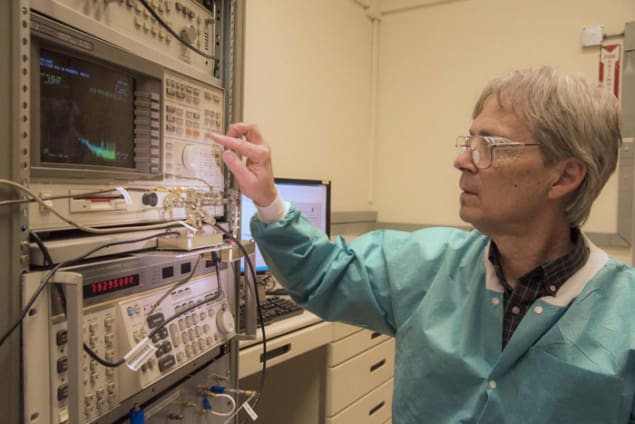
A new piezoelectric sensor can identify the most appropriate antibiotic for an infection in less than an hour, according to physicists in the US. While conventional antimicrobial tests can take days, the device detects changes in bacteria motion upon initial exposure to antibiotics. Faster antibiotic selection could improve treatment outcomes and help tackle antimicrobial resistance.
Antimicrobial susceptibility testing (AST) is used to identify the most appropriate antibiotic for a bacterial infection. Current tests are constrained by bacterial growth rates, as they examine the effect of antibiotics on the growth of bacteria colonies cultivated from patient samples. However, the two to three days this takes to produce results can cause problems.
David Livermore, medical microbiologist at the University of East Anglia and Public Health England’s lead on antibiotic resistance, told Physics World: “During the [testing period] the patient must be treated empirically, based on likely pathogens and local resistance rates. Many patients are over-treated – given potent broad-spectrum antibiotic when they transpire to have very susceptible pathogens. This is wasteful and may select resistance in the gut flora. A few have highly resistant pathogens, not covered by the empirical treatment, and so are under-treated, increasing their mortality risk.”
Major public health concern
The emergence of antibiotic resistant bacteria, which is often caused by using inappropriate or ineffective antibiotics, is a major public health concern. Resistance is rising in most pathogenic bacteria and infections that were once easily treated – such as pneumonia and gonorrhoea – are increasingly resistant to all antibiotics. In the US, antibiotic-resistant infections are responsible for at least two million illnesses and 23,000 deaths every year, according to the Centers for Disease Control and Prevention.
To accelerate AST, Ward Johnson and colleagues at the National Institute of Standards and Technology (NIST) in Boulder, Colorado are developing a biophysical method that can measure changes in mechanical fluctuations of bacteria.
Their sensor is based on thin quartz crystal disc, with an electrode on each surface. One of the electrodes is used to deliver an electrical signal that is close to the disc’s resonance frequency, while the other measures the piezoelectric voltage created by the resulting crystal vibrations.
Mechanical fluctuations
The technique involves coating the disk in bacteria. Fluctuations in the mechanical properties of the organisms affect the frequency of the output signal, which in turn can be used to detect changes in the bacteria population. To test the process, the researchers coated sensors with around two million non-resistant Escherichia coli bacteria. These were then treated in three ways: some were exposed to either polymyxin B or ampicillin (two antibiotics with different modes of action), while others received no antibiotics.
On exposure to polymyxin B, cell-generated frequency noise fell rapidly, reaching almost zero within seven minutes. Frequency noise began decreasing within 15 minutes of ampicillin being introduced, then dropped more rapidly as the bacteria cell walls began to rupture. Cell imaging and post-experiment counting of viable bacteria confirmed that efficacy of the antibiotics.
A non-motile strain of E. coli, with paralysed flagella, was used in the experiments to confirm that the frequency noise was generated by cell-wall vibrations, rather than bacteria movement. According to the researchers, the results provide evidence that bacteria cell death can be sensed through measurements of cell-generated frequency noise.
Clinically better
Ward says that the main advantage of this technique over conventional AST is speed. “Although observation of growth may remain the ultimate gold standard for predicting the effectiveness of an antibiotic in halting the progression of an infection, the timescale of such growth often makes conventional AST partly or entirely ineffective in establishing a course of treatment in many clinical situations,” he explains. “In contrast, our approach is focused on immediately sensing biophysical responses of microbes to antibiotics as these changes occur.”
Livermore says that while the results suggest that the technique “works for E. coli with polymyxin and ampicillin,” Johnson and colleagues “need to test it on a much wider range of bacterial species and antibiotics, including those that, unlike polymyxin and ampicillin, don’t rapidly kill bacteria”. He adds that if it was necessary to grow a bacteria culture from a patient sample before testing, then the time needed would be extended to around 24 hours.
Johnson hopes to achieve a level of sensitivity that will allow testing directly from clinical samples without the need for pre-culturing. He adds that “this would require add-on technologies to process the sample, to get it into the right state for passing to the resonators”.
The researchers have been granted a patent for the technique and are currently testing it on other and are currently testing it on other bacteria and antibiotics.
The research is described in Scientific Reports.



